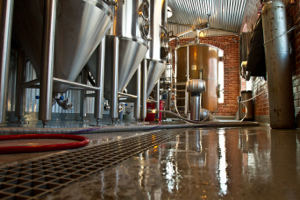Beer 101

Brewing Beer is as old as civilization
Beer is one of the world’s most popular adult beverages brewed and consumed on every continent and hundreds of nations. It is universal in appeal being served in the finest restaurants, sporting events, and neighborhood street fairs. Beer is primarily enjoyed cool or cold while some styles are best served at “cellar” temperature (about 10° F warmer than the typical refrigerator). It is is made in hundreds of unique styles ranging from dark to light, strong to weak, and simple to complex.
Beer is one of the world’s oldest alcohol beverages (although not as old as wine, which most likely was discovered accidentally). Unlike wine, Beer has to be coaxed by man as its primary ingredient, grains, must be altered by heat and water to convert the abundant starches to fermentable sugars. The brewing of beer dates back to at least the 8th millennium BC at the beginnings of agriculture. The first beers are believed to have been produced by first creating very dense bread composed of cracked grains baked in crude ovens. This bread would be broken up and added to boiling water then cooled. This cool liquid was naturally affected by ambient airborne yeasts that transformed the sweet liquid to beer.
In its purest form Beer is made with a simple recipe of water, malted barley, hops, and yeast. Beers made by the Babylonians and Egyptians do not differ greatly from beers made by craft brewers today.
Beer – Just Four Basic Ingredients
Beer in its many different styles and strengths is based upon a very simple recipe: water, malted barely, hops, and yeast. With just these four ingredients you can produce an amazing array of world class Beer styles. See our Beer Styles section to see the BevX take on Beer styles.
Water
While this ingredient may seem rather simple and perhaps universal, water is a vital factor in Beer’s flavor. While that may initially seem like a “geeky” concern and evoke a “water is water” response many of us can make sense of it by looking at the bottled water craze of the past decade plus. The fancy bottled water that fills our grocery shelves and restaurant menus often list their respective mineral content and other stats including pH. The mineral content of brewing water greatly affects the subsequent Beer often providing defining characteristics. The mineral composition of water affects Beer primarily in two ways. One, hard water and soft water simply taste different and have a unique textural feel in the mouth. Two, yeasts that produce beer eat more than just the sugars that are converted to alcohol. Yeasts feed on trace minerals provided by the brewing water that can affect the health and vigor of yeast. Healthy, long lived yeast eat more sugars producing more alcohol and minimizing any trace sugars and sweetness in the beer. Water is not just water.
Malt
Malt is the vital ingredient to Beer. It provides the essential sugars that are converted to alcohol and it provides the majority of flavor. Malt is the grape equivalent if comparing Beer to Wine. Malt is made from grain, primarily barley, followed by wheat. Unlike grapes, which are ready to go straight off the vine, grains must be coaxed, albeit naturally, in order for their fermentable sugars to become accessible. A grain or seed has all it needs to produce a plant. We all remember grade school experiments with raw seeds placed on damp cloths in Petri dishes. We watched the seed swell then sprout giving life to a plant. This infant plant was fed from sugars present in the grain as complex starches until warm damp conditions triggered a conversion known as germination. Malting is a simple process in which grains are steeped in warm, damp conditions until germination has begun and then quickly but carefully dried locking the sugars inside. At this point you have the most basic type of malt, often called pale malt, which is the base of most every all malt Beer. (Most commercial beers are made with cheaper and inferior materials known as adjuncts.) At this point the malt producer can choose to kiln the malt to deeper, darker colors ranging from light copper to black. These darker malts have varying colors, flavors, and aromas. By doing this malt producers create a wide range of malts that in turn allow the brewer to create a wide range of Beer styles.
Hops
Hops are believed to have first been used in the production of Beer in the 11th century. However, hops are very versatile and have been known to be cultivated in Germany from the mid 700s. Hops shoots when young are a tasty culinary treat, hop oils are commonly used in soaps and shampoos, and the blossoms have medicinal properties. For the brewer hops contribute aroma, bitterness, and preservative properties to Beer. In proper measure hops contribute a mildly bitter edge to the sweet malt flavors found in many Beers while also offering distinct aromas ranging from floral and citrus to earthy (common to native English varieties). Like grapes, there are many unique hop varieties. Hops are typically classified by their bittering and aromatic properties. Hop bitterness is expressed as a measure of the hop’s alpha acids. (Alpha acids of 10 and higher are quite bitter while measures of 3 to 5 are mild.)
Yeast
The influence of yeast on both Wine and Beer was not fully understood by the first producers of these beverages. Wild yeasts present on grape skins and naturally airborne yeasts performed their magic without the interference of man. In some cases, such as Lambic in Belgium, Beer is still produced by allowing the sweet malt water to be affected by the yeasts floating in surrounding air. In most cases brewers are very careful to keep their “wort” (the sweet malt water created when steeping malt in hot water) far from outside air and inoculate the wort with a yeast strain of their choosing. Like malt and hops there are many different varieties of yeast that fall in one of two basic families, Ale or Lager. Today a brewer can order specific yeast from a laboratory that specializes in keeping and propagating yeast for use in the brewing and winemaking industry. Many large brewers keep on-site labs in order to keep their yeast strains healthy and ready for action.



